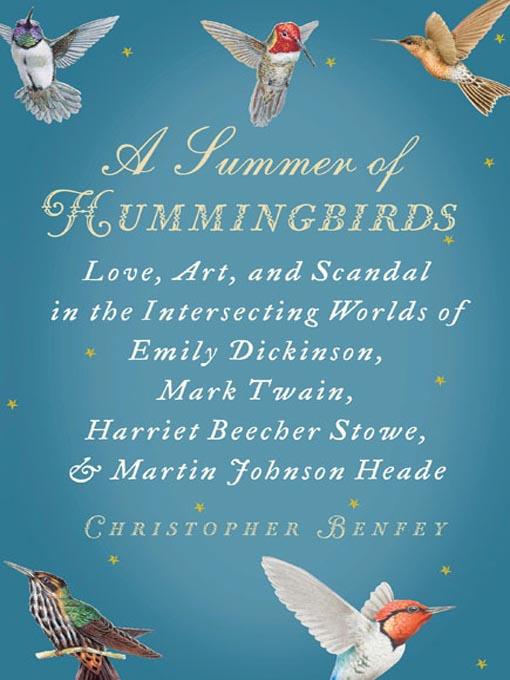
A Summer of Hummingbirds
Love, Art, and Scandal in the Intersecting Worlds of Emily Dickinson, Mark Twain, Harriet Beecher Stowe, and Martin Johnson Heade
کتاب های مرتبط
- اطلاعات
- نقد و بررسی
- دیدگاه کاربران
نقد و بررسی

February 18, 2008
Signature
Reviewed by
Debby Applegate
In his last two books, Christopher Benfey, a prolific critic, poet and professor of literature at Mount Holyoke, cultivated an unorthodox style of historical storytelling that spurns the traditional mechanics of cause and effect. To steal a phrase from poetry, we might say that he writes history in the lyric rather than the epic mode. The goal is to evoke the thoughts and feelings created by a particular time and place. He has previously applied this technique to Victorian America's discovery of Japan and Edgar Degas's year in New Orleans.
Now Benfey turns to the more familiar territory of the 19th-century literary renaissance in New England. He focuses on some of the era's most famous writers, as well as lesser-known figures—as the subtitle indicates: “Love, Art, and Scandal in the Intersecting Worlds of Emily Dickinson, Mark Twain, Harriet Beecher Stowe and Martin Johnson Heade”—all of whom found inspiration and self-expression in flowers and birds, the hummingbird above all. This is the book's MacGuffin: “why did hummingbirds in particular elicit such a powerful attraction, rising at times to an obsession?”
Benfey's answer is that after the Civil War Americans “gradually left behind a static view of existence, a trust in fixed arrangements and hierarchies,” and came to embrace a new dynamism that “found perfect expression in the hummingbird.” By tracing their allusions to hummingbirds in poems, pictures, sermons and anecdotes, he shows how these sensitive souls registered the shock of war by seeking symbols of the evanescence of life.
The elegiac mood gives way near the end, when sex wrestles the spotlight from death. Stowe's brother, a celebrated preacher, ensnares himself in a sex scandal, Heade begins a flirtation with the magnetic Mabel Loomis Todd, who throws him over for Dickinson's married brother, and the reclusive poetess embarks on her own late-life love affair.
Whether Benfey's book succeeds depends on the expectations of the reader. This is not a conventional cultural history, nor is it a linear history of literary influences. Instead, to borrow from a description of Dickinson's hummingbird poems, it presents “a fusion of realistic detail and vaporous suggestion.” Those who aren't already familiar with the period—and even many who are —might drift as the author flits, birdlike, from one poignant tableau to another, beckoned by the wafting scent of yet another reference to birds or flowers. (He suffers some minor errors of fact and interpretation, due to an excessive dependence on secondary sources, but they don't alter the overall effect.)
This book fares best when seen not as an argument but as a meditation on a moment in history, in which the reading experience itself recreates those feelings of evanescence.
Debby Applegate won the 2007 Pulitzer Prize for the biography
The Most Famous Man in America (Doubleday).

April 1, 2008
Literary professor, scholar, and critic Benfey ("The Great Wave: Gilded Age Misfits, Japanese Eccentrics, and the Opening of Old Japan") examines the intertwining lives of several American writers and artists in postCivil War America. Contending that while these were years of societal instability, as much had changed after the war, Benfey likewise sees this era as a time of liberation for this group of gifted men and women. Readers gain insight into the behavior of an extended cast of characters including renowned preacher/orator Henry Ward Beecher; writer and painter Mabel Loomis Todd; Austin Dickinson, Emily Dickinson's prominent attorney brother; and painter Martin Johnson Heade. Their parallel interestse.g., travel and exploration of warmer climates, obsessions with the hummingbird (a bird native only to the Americas) and the trailing arbutus flower, and a fascination with the English romantic writer Lord Byronare also emphasized. It is clear the author seeks to enlighten, and he achieves that goal with this scholarly yet intimate behind-the-scenes glimpse into the lives of some of our most important artists. Recommended for larger academic libraries.M. Neville, Trenton P.L., NJ
Copyright 2008 Library Journal, LLC Used with permission.

April 15, 2008
Benfeys subtitle neatly conveys the fascinating and sometimes tortuous complexities of this literary/historical snapshot of postCivil War America. In fact, the subtitle is incomplete, leaving out, as it does, several equally prominent figures who appear throughout the interweaving stories explored here (Henry Ward Beecher, Thomas Wentworth Higginson, and Lord Byron, among others). Benfey finds a common connection among these diverse characters through, improbably, hummingbirds, an intense interest in which seems to have taken hold of artists and writers throughout the late nineteenth century. Benfeys eclectic and original approach brings this period and these personalities vividly to life. He presents sensitive critiques of literature and art alongside tales of illicit love and broken, bent, or triumphant lives, all of which makes for compelling reading for specialist and nonspecialist alike.(Reprinted with permission of Booklist, copyright 2008, American Library Association.)

























دیدگاه کاربران